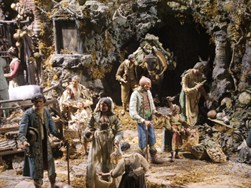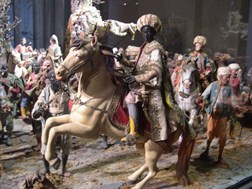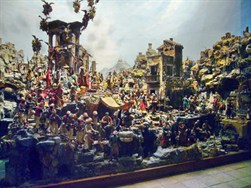Some famous examples of Neapolitan Nativity scenes in Southern Italy
 One of the most famous examples of Neapolitan Nativity scene is preserved and visible to the public every Christmas in the Royal Palace of Caserta. Under the Bourbon dynasty, and especially during the reign of Charles III, the Nativity scene enjoyed a great reputation at court and not only artists were specially chosen for the occasion, but also several members of the court itself were involved. Another sovereign with a great passion for the Nativity scene was Francis IFrancis I of Bourbon (1777-1830) was King of the Two Sicilies for only five years, from 1825 until his death. He was the second son of Ferdinand IV and Maria Carolina of Austria., while his son Ferdinand IIFerdinand II of Bourbon (1810-1859), the son of Francis I, was King of the Two Sicilies from 1830 until his death in 1859. His kingdom underwent a major series of bureaucratic and economic reforms, as well as the installation of a number of important infrastructures. He had to face the popular uprising of 1848, healed the finances of the kingdom, but was also criticized for his government’s absolutist mould. He was succeeded by his son Francis II, the last King of the Two Sicilies before the unification of Italy. was the last of the Bourbons to set up the Nativity scene in the Sala della Rachetta (Hall of the racket): this Bourbon Nativity scene was set up by Salvatore FergolaSalvatore Fergola (1799-1874) was an Italian painter. He was born and died in Naples, where he became famous as an important landscape painter. He was court painter to the Bourbons, an authoritative exponent of the so-called “Scuola di Posillipo” and worked on the decoration of the Royal Palace of Naples. on the walls of the new room of the Nativity scene. The Nativity scene, recently restored after most of the pastors had been stolen, is now located in an elliptical room inside the section of the palace known as the “Old Apartment”. Painted white and unadorned, the hall was the scene of events, feasts and entertainment for the court. As mentioned, great neapolitan artists contributed to the making of the Nativity scene, first among them the Neapolitan Giuseppe SammartinoGiuseppe Sammartino (1720-1793) was an important Italian sculptor, a leading figure in the art scene of eighteenth century Naples. His most famous work is undoubtedly the marble Veiled Christ made for the chapel of the Princes of Sangro di San Severo in Naples, the Cappella San Severo. But in his long career Sammartino was the author of other great works, such as the decoration of the altar of the Church of the Nunziatella (Annunciation). He was also a creator of Nativity scenes., the main exponent of Neapolitan eighteenth-century sculpture. He, like the other artists who took turns in setting up the Nativity scene at the court, created the most important figures in terracotta, while clay was used for the heads and limbs of the other characters and the rest were in wire and oakum. The Nativity scene was placed, according to a classical and rigid scheme, on a cork “rock”, divided into the canonical scenes of the Nativity, the Annunciation to the shepherds and the inn. In addition to the artists, the princesses and ladies of the court helped enrich the individual figures with jewels, sumptuous fabrics and clothes.
One of the most famous examples of Neapolitan Nativity scene is preserved and visible to the public every Christmas in the Royal Palace of Caserta. Under the Bourbon dynasty, and especially during the reign of Charles III, the Nativity scene enjoyed a great reputation at court and not only artists were specially chosen for the occasion, but also several members of the court itself were involved. Another sovereign with a great passion for the Nativity scene was Francis IFrancis I of Bourbon (1777-1830) was King of the Two Sicilies for only five years, from 1825 until his death. He was the second son of Ferdinand IV and Maria Carolina of Austria., while his son Ferdinand IIFerdinand II of Bourbon (1810-1859), the son of Francis I, was King of the Two Sicilies from 1830 until his death in 1859. His kingdom underwent a major series of bureaucratic and economic reforms, as well as the installation of a number of important infrastructures. He had to face the popular uprising of 1848, healed the finances of the kingdom, but was also criticized for his government’s absolutist mould. He was succeeded by his son Francis II, the last King of the Two Sicilies before the unification of Italy. was the last of the Bourbons to set up the Nativity scene in the Sala della Rachetta (Hall of the racket): this Bourbon Nativity scene was set up by Salvatore FergolaSalvatore Fergola (1799-1874) was an Italian painter. He was born and died in Naples, where he became famous as an important landscape painter. He was court painter to the Bourbons, an authoritative exponent of the so-called “Scuola di Posillipo” and worked on the decoration of the Royal Palace of Naples. on the walls of the new room of the Nativity scene. The Nativity scene, recently restored after most of the pastors had been stolen, is now located in an elliptical room inside the section of the palace known as the “Old Apartment”. Painted white and unadorned, the hall was the scene of events, feasts and entertainment for the court. As mentioned, great neapolitan artists contributed to the making of the Nativity scene, first among them the Neapolitan Giuseppe SammartinoGiuseppe Sammartino (1720-1793) was an important Italian sculptor, a leading figure in the art scene of eighteenth century Naples. His most famous work is undoubtedly the marble Veiled Christ made for the chapel of the Princes of Sangro di San Severo in Naples, the Cappella San Severo. But in his long career Sammartino was the author of other great works, such as the decoration of the altar of the Church of the Nunziatella (Annunciation). He was also a creator of Nativity scenes., the main exponent of Neapolitan eighteenth-century sculpture. He, like the other artists who took turns in setting up the Nativity scene at the court, created the most important figures in terracotta, while clay was used for the heads and limbs of the other characters and the rest were in wire and oakum. The Nativity scene was placed, according to a classical and rigid scheme, on a cork “rock”, divided into the canonical scenes of the Nativity, the Annunciation to the shepherds and the inn. In addition to the artists, the princesses and ladies of the court helped enrich the individual figures with jewels, sumptuous fabrics and clothes.
 Equally famous is the Nativity scene preserved in the Palatine Chapel in the Royal Palace of Naples, the result of various collections of the Bank of Naples in order to present a model of an eighteenth-century Neapolitan nativity scene. The 210 figures and 144 accessories come in fact from Nativity scenes which were dismantled, sold or dispersed in the early nineteenth century. Many of the components of the Bank of Naples’s Nativity scene were built in the eighteenth century by great artists such as Sammartino, Angelo VivaAngelo Viva (1748-1837) was a Neapolitan sculptor, a pupil of Giuseppe Sammartino., Lorenzo Mosca, Salvatore FrancoA student and collaborator of Sammartino’s, Salvatore Franco was a sculptor in marble and stucco, and author of polychrome terracotta figures for Nativity scenes. Born in Naples, he was active between 1770 and 1815., Giuseppe Gori, Francesco and Camillo CelebranoFrancesco Celebrano (1729-1814) was a sculptor and painter in the service of Ferdinand IV of Bourbon, a great decorator of porcelain and author of an important production of Nativity scenes. His son Camillo, whose date of birth is unknown but who was active between 1780 and 1828, was trained by his father and he continued his work especially in the construction and decoration of Nativity scenes. and Matteo BottiglieroMatteo Bottigliero or Bottiglieri (1684-1757) was an important eighteenth-century Neapolitan artist, sculptor and painter. Like other artists of his generation, he became known for his rich production of Nativity scenes.. The scene is typical of the Neapolitan Nativity scene with the Holy Family placed on the classic rock in front of the ruins of a pagan temple, the tavern and the rich set of characters taken from the Biblical accounts (such as the Magi) or from the Neapolitan folk tradition (such as pipers, merchants, the baker or the farrier).
Equally famous is the Nativity scene preserved in the Palatine Chapel in the Royal Palace of Naples, the result of various collections of the Bank of Naples in order to present a model of an eighteenth-century Neapolitan nativity scene. The 210 figures and 144 accessories come in fact from Nativity scenes which were dismantled, sold or dispersed in the early nineteenth century. Many of the components of the Bank of Naples’s Nativity scene were built in the eighteenth century by great artists such as Sammartino, Angelo VivaAngelo Viva (1748-1837) was a Neapolitan sculptor, a pupil of Giuseppe Sammartino., Lorenzo Mosca, Salvatore FrancoA student and collaborator of Sammartino’s, Salvatore Franco was a sculptor in marble and stucco, and author of polychrome terracotta figures for Nativity scenes. Born in Naples, he was active between 1770 and 1815., Giuseppe Gori, Francesco and Camillo CelebranoFrancesco Celebrano (1729-1814) was a sculptor and painter in the service of Ferdinand IV of Bourbon, a great decorator of porcelain and author of an important production of Nativity scenes. His son Camillo, whose date of birth is unknown but who was active between 1780 and 1828, was trained by his father and he continued his work especially in the construction and decoration of Nativity scenes. and Matteo BottiglieroMatteo Bottigliero or Bottiglieri (1684-1757) was an important eighteenth-century Neapolitan artist, sculptor and painter. Like other artists of his generation, he became known for his rich production of Nativity scenes.. The scene is typical of the Neapolitan Nativity scene with the Holy Family placed on the classic rock in front of the ruins of a pagan temple, the tavern and the rich set of characters taken from the Biblical accounts (such as the Magi) or from the Neapolitan folk tradition (such as pipers, merchants, the baker or the farrier).
 Finally, the Nativity scene which was set up in December 1879 thanks to the figures donated by Michele CucinielloMichele Cuciniello (1823-1889) was a Neapolitan playwright. A great collector of pastors and objects of Neapolitan Nativity scenes, in 1879 he donated his collection to the Museum of San Martino in Naples, where the Nativity scene that bears his name is still preserved., from whom it takes its name, and which is visible and on permanent display at the National Museum of San Martino (picture 3) is also of great historical and artistic value. Characters, animals and accessories dating back to the period between the second half of the eighteenth and the first half of the nineteenth century are arranged in various scenes according to the Cuciniello’s own dispositions and other characters in the Neapolitan cultural scene of the nineteenth and twentieth centuries. Again, there are clear elements typical of the Neapolitan nativity scene, such as the presence of ruins of ancient pagan temples (to symbolize the victory of Christianity over the pagan world) and a set of characters that represent everyday life in Naples in the later part of Early Modern period.
Finally, the Nativity scene which was set up in December 1879 thanks to the figures donated by Michele CucinielloMichele Cuciniello (1823-1889) was a Neapolitan playwright. A great collector of pastors and objects of Neapolitan Nativity scenes, in 1879 he donated his collection to the Museum of San Martino in Naples, where the Nativity scene that bears his name is still preserved., from whom it takes its name, and which is visible and on permanent display at the National Museum of San Martino (picture 3) is also of great historical and artistic value. Characters, animals and accessories dating back to the period between the second half of the eighteenth and the first half of the nineteenth century are arranged in various scenes according to the Cuciniello’s own dispositions and other characters in the Neapolitan cultural scene of the nineteenth and twentieth centuries. Again, there are clear elements typical of the Neapolitan nativity scene, such as the presence of ruins of ancient pagan temples (to symbolize the victory of Christianity over the pagan world) and a set of characters that represent everyday life in Naples in the later part of Early Modern period.
